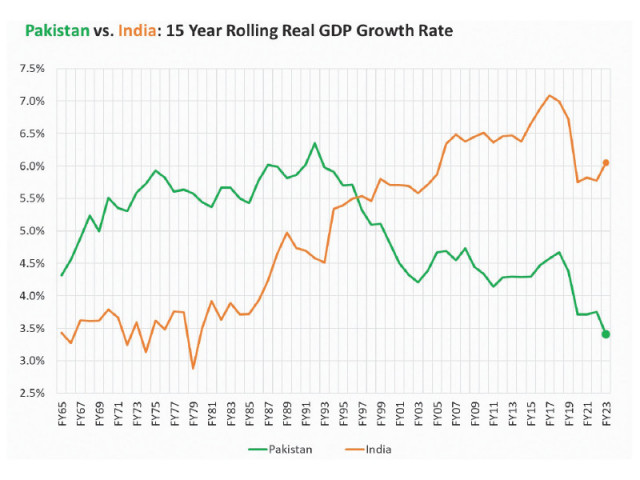Pakistan on silent economic decline
Data reveals stark realities as growth falters, income gap threatens stability

Optimus Capital Management (OCM) launched two infographs during Eid holidays, showing Pakistan’s economy grew much better than India from 1965-1990, with growth exceeding 6% in 1991-92. However, since then, it has been on a persistent decline, reducing to an average growth rate of 3.4% in the past 15 years.
The economy is projected to further slow down and average out at 2% over the next five years, widening income disparity, increasing poverty, and boosting joblessness.
On the other hand, India’s economic growth rate surpassed Pakistan in the 1990s and has continued to grow over the past 27 years to date.
While commenting on the graphs, Senior Economist Dr Ashfaque Hasan Khan said the graphs simply depict a sorry state in Pakistan. One of the two graphs illustrates how Pakistan’s economy is gradually sinking in front of our eyes, and we are mere silent spectators.
The graph presents 15 years rolling real GDP growth of Pakistan since 1965. As can be seen, it exhibits a declining trend. The real GDP growth has slowed to an average of 3.4% per annum over the last 15 years.
Going forward, this growth will further slow down. Imagine an economy growing by 3.4% per annum with a population growing by 2.5%. Hence, the real per capita income, on average, is growing by less than 1% per annum, which is neither here nor there. This simply suggests that our real living standard has remained stagnant on average. It means the living standards of the bulk of the people have declined, while it has increased for some people. This is also a sign of widening income inequality.
“Despite all these things, the economy is not on the radar of the successive governments. In fact, we have outsourced our economic management to the IFIs (international financial institutions like the International Monetary Fund and World Bank). May God protect Pakistan and its people, particularly the poor and downtrodden.”
Another graph compares the growth experiences of Pakistan and India. As can be seen from the graph, Pakistan was doing far better than India until 1990. “As we move into the decade of the 1990s, Pakistan’s economic downturn became clear. The decline continued until 2002-03. Pakistan started recovering slightly in 2003-04 until 2007-08, and since then, there has been no looking back.”
India, on the other hand, continued to maintain a rising trend in its growth trajectory.
What caused Pakistan’s economic downturn starting in the decade of the 1990s? “In my view (many would disagree with my answer, but they have every right to disagree with me), two things made the difference – the bari bari regime (rotational government by political parties) in the 1990s and the IMF programme….devaluation, keeping interest rates high, senseless taxation, and austerity (raising the prices of utilities),” Khan said.
Read Govt blamed for economic, security meltdown
Since 2003-04, Pakistan came out of the IMF programme until 2007-08. Pakistan was making its own policies, and there was no bari bari regime.
Since 2008-09 until today, however, Pakistan has remained under successive IMF programmes. Pakistan has outsourced its policymaking to the IFIs, and hence our economy continued to witness a declining trend.
The former dean of NUST, Khan said devaluation, high-interest rates, senseless taxation, and rising prices of utilities have made our industries non-competitive in international markets. Industrial production continued to witness a decelerating trend. Agricultural growth, on average, continued to grow slightly above the country’s population growth. Hence, our reliance on food import continued to rise. The services sector continued to grow, primarily by an extraordinary growth in banking and finance. Pakistan’s banking and financial sector continued to earn extraordinary profits because of the State Bank of Pakistan keeping its policy rate extraordinarily high.
“Pakistan will remain under the IMF programme for at least another 5 years. Hence, growth deceleration will continue. I can expect our economic growth to slow down further to 2% per annum during the next 5 years. Poverty, unemployment, and debt accumulation will be the natural outcomes for Pakistan,” Khan said.
Speaking to The Express Tribune, OCM CEO Asif Qureshi said there is no rocket science behind the graphs. They are developed using publicly available data. The graphs simply show that the two bordering countries, both of which gained independence in 1947, are growing in two opposite directions due to local policies and international geopolitics.
He said the Indian government and its public sector are not better than Pakistan’s. Both are equally poor. However, India’s quality education up to the higher education level, vibrant private sector, and focus on science and technology helped its economy boom.
India has remained the West’s darling under geopolitics, winning global backing. This offers a large consumer-based economy to the world with a population size of 1.3 billion people.
Published in The Express Tribune, April 13th, 2024.
Like Business on Facebook, follow @TribuneBiz on Twitter to stay informed and join in the conversation.



















COMMENTS
Comments are moderated and generally will be posted if they are on-topic and not abusive.
For more information, please see our Comments FAQ